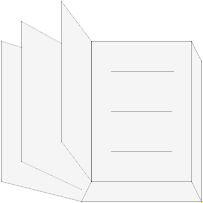 Package Modelica.Magnetic.QuasiStatic.FluxTubes.UsersGuide
Package Modelica.Magnetic.QuasiStatic.FluxTubes.UsersGuideUser's Guide
 Package Modelica.Magnetic.QuasiStatic.FluxTubes.UsersGuide
Package Modelica.Magnetic.QuasiStatic.FluxTubes.UsersGuide
The quasi static flux tubes library is based on the transient library Magnetic.FluxTubes. The main principles of confined flux and flux tubes apply, too. The quasi static flux tubes library contains components for modelling of electromagnetic devices with lumped magnetic networks based on quasi static theory. Models based on this library are suited for quasi static simulation of transformers at component and system level.
The quasi static components of this library do not consider saturation since linearity is strictly assumed. In case that the permeability of a saturated circuit needs to be considered, a transient permeability estimation sensor is provided do determine the effective permeability from a transient simulation.
A general introduction into quasi static (quasi stationary) phasor can be found in Modelica.Electrical.QuasiStationary.
This user's guide gives a short introduction to the underlying concept of quasi static magnetic flux tubes, summarizes basic relationships and equations.
Extends from Modelica.Icons.Information (Icon for general information packages).
| Name | Description |
|---|---|
Contact | Contact |
FluxTubeConcept | Flux tube concept |
Literature | Literature |
ReleaseNotes | Release Notes |
 Class Modelica.Magnetic.QuasiStatic.FluxTubes.UsersGuide.FluxTubeConcept
Class Modelica.Magnetic.QuasiStatic.FluxTubes.UsersGuide.FluxTubeConcept
Following below, the concept of magnetic flux tubes is outlined in short. For a detailed description of flux tube elements, please have a look at the listed literature. Magnetic flux tubes enable the modeling of magnetic fields with lumped equivalent circuit networks.
Since quasi static conditions are assumed, each field quantity can be represented by a complex phasor -- which is indicated by underlining the respective variable:




The figure below and the following equations illustrate the relationships between

A flux tube confines the magnetic flux. Flied lines, and flux tubes, respectively are always closed. So there is no flux entering or leaving a flux tube. The total flux of a configuration can be represented by parallel flux tubes, representing different flux paths. This is considered by connecting the elements of a lumped circuit model, such that the sum of all fluxes of a connection is equivalent to zero.
For a section of a flux tube with length
 the magnetic potential difference is determined by the length integral over the magnetic field strength:
the magnetic potential difference is determined by the length integral over the magnetic field strength:

The magnetic flux entering, and leaving a flux tube, respectively, is determined by the surface integral of the normal component of the magnetic field strength:

The magnetic potential difference and the magnetic flux have the same angle, so the reluctance a real (non complex) quantity:

For a
generic flux tube reluctance with constant
area of cross section,
 ,
and length,
,
and length,
 ,
the magnetic reluctance is:
,
the magnetic reluctance is:

The parameter and variable names are chosen as close as possible to the transient FluxTubes library, to avoid additional effort when converting transient into quasi static flux tubes models.
A similar approach on quasi static flux tube models is published in [Raabe2012].
Extends from Modelica.Icons.Information (Icon for general information packages).
 Class Modelica.Magnetic.QuasiStatic.FluxTubes.UsersGuide.Literature
Class Modelica.Magnetic.QuasiStatic.FluxTubes.UsersGuide.Literature
| [Raabe2012] | N. Raabe, " An approach for modelling quasi-stationary magnetic circuits," Modelica Conference, pp. 167-172, 2012. |
Additional reference on magnetic flux tubes are listed in Modelica.Magnetic.FluxTubes.
Extends from Modelica.Icons.References (Icon for external references).
 Class Modelica.Magnetic.QuasiStatic.FluxTubes.UsersGuide.ReleaseNotes
Class Modelica.Magnetic.QuasiStatic.FluxTubes.UsersGuide.ReleaseNotes
Extends from Modelica.Icons.ReleaseNotes (Icon for release notes in documentation).
 Class Modelica.Magnetic.QuasiStatic.FluxTubes.UsersGuide.Contact
Class Modelica.Magnetic.QuasiStatic.FluxTubes.UsersGuide.Contact
Dr. Christian Kral
Electric Machines, Drives and Systems
A-1060 Vienna, Austria
email: dr.christian.kral@gmail.com
Anton Haumer
Technical Consulting & Electrical Engineering
D-93049 Regensburg, Germany
email: a.haumer@haumer.at
Extends from Modelica.Icons.Contact (Icon for contact information).